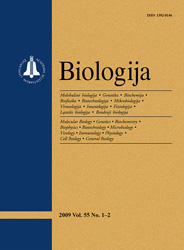 ISSN 1392-0146 ISSN 2029-0578 (online) |
2008 m. Nr. 2 Winterhardiness as the key factor for selecting accessions of Medicago sativa L. high-yielding germplasm
The ultimate purpose of developing new varieties of Medicago spp. is selection of the initial genetic material characteristics responsible for the stabile yield of dry matter. The greatest shortcomings of conventional methods used to determine herbage yield are labour-consuming cuts and the processing of harvested green matter. The main task of the present studies was evaluation of the genetic material of Medicago sativa L. developed using germplasms received from different regions with an impact on winter hardiness and relations with this trait to other properties of accessions. The experiment was conducted at the Lithuanian Institute of Agriculture (LIA) during 2004–2006. Low winterhardiness highly negatively (r = –0.85*, significant at P = 0.05) correlated with spring re-growth and negatively affected (r = –0.65*) the dry matter yield of the first cut. Effective spring re-growth positively (r = 0.41*) influenced plant height before the 1st cut and medium positively (r = 0.66*) the yield of the 1st cut as well as total yield (r = 0.62). Analysis showed that the influence of winterhardiness on the yield of lines with different resistance was considerable. The least damaged lines yielded on average 8.67 t ha–1, whereas most severely damaged lines yielded 5.43 t ha–1 or 37.4% less. Plant height before the 1st cut showed a weaker effect than winterhardiness and spring re-growth. Lines with highest differences in height produced a herbage yield whose differences varied within 25% for the 1st cut and 17% for total yield. Plant height sequentially decreased at every later regrowth and cutting time. Plants of populations with highest winterhardiness were on average slightly lower than those with poor winterhardiness. The highest plants (97 cm) at the 1st cut were found in populations LIA2104, LIA9//10, LIA2358, LIA 2311 with a medium winterhardiness level. The percentage of dry matter in herbage yield decreased with every cut. The highest decrease of dry matter content (25.4% to 20.3%) was observed in populations with a high winterhardiness. Winterhardiness and spring re-growth were the most effective indirect criteria for selecting high-yielding lines among the initial breeding material of Medicago spp. Keywords: Medicago sativa, dry matter yield, spring re-growth, plant height |
Issues:
2011 - Vol.57 No. 1, No. 2, No. 3 2010 - Vol.56 No. 1-4 2009 - Vol.55 No. 1-2, No. 3-4 2008 - Vol.54 No. 1, No. 2, No. 3, No. 4 2007 - Vol.53 No. 1, No. 2, No. 3, No. 4 2006 No. 1, No. 2, No. 3, No. 4 2005 No. 1, No. 2, No. 3, No. 4 2004 No. 1, No. 2, No. 3, No. 4 2003 No. 1, No. 2, No. 3, No. 4 2002 No. 1, No. 2, No. 3, No. 4 2001 No. 1, No. 2, No. 3, No. 4 |